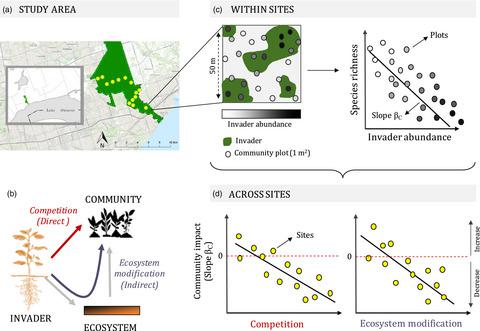Our official English website, www.x-mol.net, welcomes your
feedback! (Note: you will need to create a separate account there.)
Invasion drives plant diversity loss through competition and ecosystem modification
Journal of Ecology ( IF 5.3 ) Pub Date : 2021-06-30 , DOI: 10.1111/1365-2745.13739 Marta Carboni 1, 2 , Stuart W. Livingstone 1, 3 , Marney E. Isaac 3 , Marc W. Cadotte 1, 3
中文翻译:

入侵通过竞争和生态系统改造导致植物多样性丧失
更新日期:2021-06-30
Journal of Ecology ( IF 5.3 ) Pub Date : 2021-06-30 , DOI: 10.1111/1365-2745.13739 Marta Carboni 1, 2 , Stuart W. Livingstone 1, 3 , Marney E. Isaac 3 , Marc W. Cadotte 1, 3
Affiliation

|
- Although invasive plants increasingly contribute to the current biodiversity crisis, the mechanisms through which they impact native communities are still poorly understood. Community ecology theory has emphasized direct competitive displacement over common resources, but invasion-driven ecosystem modifications, such as altered soil pH, might also have consequences for plant diversity. However, the relative importance of ecosystem modification compared to direct resource competition has rarely been tested.
- Here we studied the invasive vine Vincetoxicum rossicum across invaded meadows in southern Ontario, Canada. In each meadow site, we quantified: (a) the strength of impact on the resident plant community, (b) the potential for competition with resident species (as the degree of niche dissimilarity and competitive superiority to the residents based on their functional traits) and (c) the amount of ecosystem modification related to invasion.
- We found that impacts on plant biodiversity were more negative where the invader had greater potential to competitively displace species (because it had a similar niche as the residents or was competitively superior), but also where it strongly altered soil N pools, moisture and pH.
- Synthesis. Our case study suggests that while competition is undoubtedly an important driver of invasion impact, ecosystem modifications can have cascading effects on plant communities, thereby magnifying the impacts of biological invasions.
中文翻译:

入侵通过竞争和生态系统改造导致植物多样性丧失
- 尽管入侵植物越来越多地导致当前的生物多样性危机,但它们影响本地社区的机制仍然知之甚少。社区生态学理论强调对公共资源的直接竞争性置换,但入侵驱动的生态系统改变,如土壤 pH 值的改变,也可能对植物多样性产生影响。然而,与直接资源竞争相比,生态系统改造的相对重要性很少经过测试。
- 在这里,我们研究了加拿大安大略省南部入侵草地上的入侵藤蔓Vincetoxicum rossicum。在每个草甸地点,我们量化了:(a)对常驻植物群落的影响强度,(b)与常驻物种竞争的潜力(作为生态位差异的程度和基于居民功能特征的竞争优势) (c) 与入侵相关的生态系统改变量。
- 我们发现,当入侵者有更大的潜力来竞争性地取代物种(因为它具有与居民相似的生态位或具有竞争优势)时,对植物生物多样性的影响更为负面,而且在它强烈改变土壤氮库、水分和 pH 值的情况下也是如此。
- 合成。我们的案例研究表明,虽然竞争无疑是入侵影响的重要驱动因素,但生态系统的改变会对植物群落产生连锁效应,从而放大生物入侵的影响。











































 京公网安备 11010802027423号
京公网安备 11010802027423号